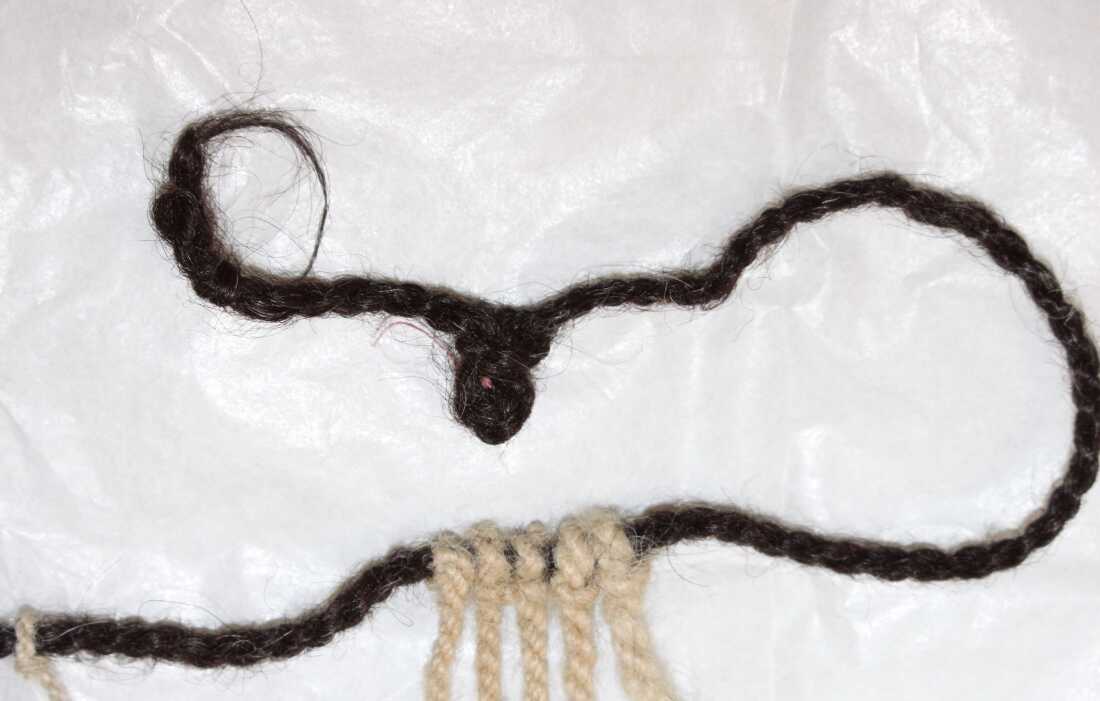A cotton and agave fiber Inca khipu is seen at an exhibit on the Smithsonian Nationwide Museum of the American Indian in 2015 in Washington, D.C.
Brendan Smialowski/AFP through Getty Photos
disguise caption
toggle caption
Brendan Smialowski/AFP through Getty Photos
The Inca Empire in South America, one of the highly effective pre-Columbian societies, was recognized for a lot of improvements — such because the structure of Machu Picchu, an intensive street community, and a system of terraces for agriculture. Maybe most unusual, although, was the society’s methodology of holding information generally known as khipu, which includes a system of tying knots to encode info.
It is lengthy been assumed that khipu manufacturing was the area of this civilization’s ruling elites, however a brand new evaluation of a wire made out of human hair finds that even low-class commoners could have engaged on this custom.
The invention could assist researchers rewrite their understanding of this side of Incan civilization, and propel extra scientists to check different khipus sitting in museum collections.
“The Incas had the largest empire in the New World at the time. It covered half of a continent, pretty much,” says Sabine Hyland, a researcher with the College of St. Andrews in Scotland, who factors out that this huge empire of thousands and thousands of individuals relied totally on knotted cords for holding information.
The Inca Empire is usually cited because the uncommon exception to the overall rule that empires will need to have a type of written expression, says Package Lee, a analysis affiliate with the college, however that is solely as a result of “khipus get overlooked as a form of writing.”
These uncommon recording units are bunches of knots tied in lengthy, coloured cords. Usually, cords hold like pendants from one thick main strand. The Inca Empire was conquered by the Spanish in 1532, and solely a tiny proportion of historic Incan khipus have survived.
Not too long ago, although, Hyland’s college acquired a khipu, and radiocarbon relationship indicated that it was from across the 12 months 1498. Hyland initially assumed it was made from hair from animals like llamas or alpacas.
However then she confirmed it to Lee. “Kit looked at me and said, ‘Sabine, this primary cord is human hair,'” Hyland remembers.

The darkish brown main wire of this khipu is made from human hair.
Sabine Hyland
disguise caption
toggle caption
Sabine Hyland
The researchers knew that traditionally, incorporating hair might function a type of signature that indicated who had made the khipu. And this meant they’d an uncommon alternative to search out out extra about an historic khipu’s creator.
The hairs on this one are about three toes lengthy and symbolize years of development. The researchers took samples from every finish of a strand and did a lab evaluation of parts like carbon and nitrogen, to get clues about what this individual will need to have eaten throughout their lifetime.
Within the journal Science Advances, they and their colleagues report that the hair got here from somebody who ate legumes, grains, and tubers. They did not see proof of an abundance of meat or maize beer, the everyday food plan of the ruling class.
Whereas it is doable {that a} high-ranking official would possibly select to not eat meat for some cause, says Hyland, it is unlikely they might get by with out ingesting a lot of maize beer. “It’s not really possible to escape drinking it,” says Hyland. “Even today, in the Andes, when you participate in rituals, you have to drink what you are given.”
This hair evaluation provides one other piece of proof to the rising perception that khipu manufacturing and literacy may need been extra widespread within the Inca Empire than the Spanish colonizers assumed and recorded of their accounts.
This implies a relationship between the khipus of the Incan Empire and extra fashionable khipus created from the 1800s to in the present day, says Lee.
“Modern khipus tend to be made by lower-status people — hacienda workers, peasant laborers, herders,” Lee says, explaining that fashionable khipus are likely to have a special form and construction from historic ones. Some fashionable khipus encode agricultural information, whereas others are buried with family members in funeral rites.
“It’s been pretty controversial to draw this continuity between Inca khipus and modern khipus, partly because of the perception that Inca khipus were made by elites,” says Lee.
Manny Medrano, a khipu researcher with Harvard College who was not a part of this examine, says this examine is “unprecedented” in the way in which it analyzed the hair.
Whereas specialists have lengthy seen human hair in khipus, he says, that is the one Inca-era one he is aware of of that has the first wire totally made from human hair. “The main cord is really important in khipus,” says Medrano.
Museums maintain tons of of khipus which have by no means been studied by specialists, he says, and this examine is prone to encourage a re-look at ones which were scrutinized earlier than.
“I would not not be surprised if we find other khipus with substantial amounts of human hair in them in the future,” he says, and that hair would possibly present a approach to perceive khipu manufacturing within the Inca Empire that is distinct from the tales written down by colonizers, who could not have totally understood what was actually occurring.
“Ultimately, this gets us closer to being able to tell Inca histories using Inca sources,” says Medrano. “We need to tell a story of literacy and of writing and of recordkeeping in the Inca Empire that is way more plural, that includes folks who have not been included in the standard narrative.”








